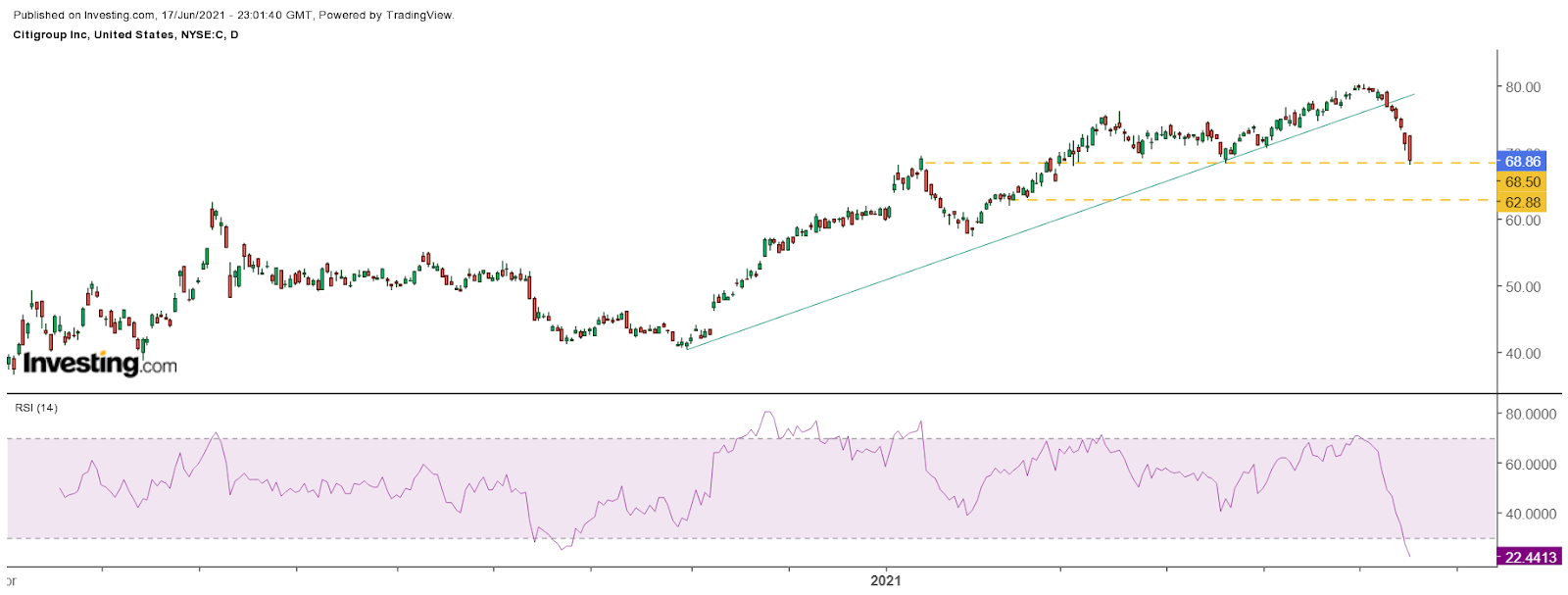This article was written exclusively for Investing.com
Financial stocks have come under considerable pressure over the past week, which could be the start of something much bigger. Bond rates have fallen on the long end of the yield curve, resulting in spreads contracting. The widening spreads and rising rates helped lift bank stocks over several months; tightening spreads and sinking rates will push these stocks lower.
Add to this recent news that JPMorgan (NYSE:JPM) and Citigroup (NYSE:C) expect second-quarter trading revenue to be weaker than in past quarters. Activity in the broader equity markets appears to have calmed dramatically over the past few months, and lighter trading volumes will not help these banks as we head into the third quarter.
Tightening Spreads
The biggest problem for the banks is the falling interest rates on the longer-end and rising rates on the shorter end. For example, 10-year yields have fallen by more than 20 basis points since May 13, to 1.5%. Meanwhile, the 2-year yield has risen by around 6 bps to 21 bps over the same time. This has tightened the spread to 1.29% from a peak of 1.55% on May 13.

As the spread compress further, it is possible the bull run in banks is over, and these stocks will decline even more. Although it may seem hard to believe, given the amount of talk around inflation and rising rates, there is a genuine possibility this happens.
The Pivot
The Fed made a significant pivot on Wednesday when their quarterly projection showed two rate hikes by 2023. The forecast showed overnight federal funds rates rising to 60 bps. That is much higher than the current 21 bps of the 2-year bill. That means that over time markets are likely to begin to anticipate rate hikes. That anticipation is what will push yields higher on the short end of the curve.
Additionally, as long as market forces continue to stay in play and central banks like the Fed and the ECB continue to buy longer-dated bonds, rates on the long end of the curve are likely to remain contained. Also, commodity prices are falling sharply, and should the dollar strengthen further, those commodity prices will fall even more. This means the recent spike in inflation will decline, sending rates on the long end even lower.

Technicals Breaking
The technical in the banks is suggesting there may be more pain to the downside. JPMorgan is already exhibiting several bearish trends after breaking a critical uptrend that started in late 2020. This coupled with a relative strength index that is now trending lower, suggests that the stock may have changed trends, and appears to be heading towards its next level of support, around $146.
The trends in Citigroup are just as bad, with the same long-term uptrend now broken and a relative strength index that has reversed lower. Both indicate that Citigroup likely faces a reversal of its long-term trend, and a break below support at $68.50 may send the stock to around $63.

A breakdown in the financial sector could be a big problem for the broader market if this trend persists. By the end of May, the financial sector contributed nearly 3.1% to the S&P 500 return of 12.6%, based on S&P Dow Jones Indices data. If the financials fall further, the broader index will need another sector to pick up the slack. It may fall on the shoulders of technology once again.
